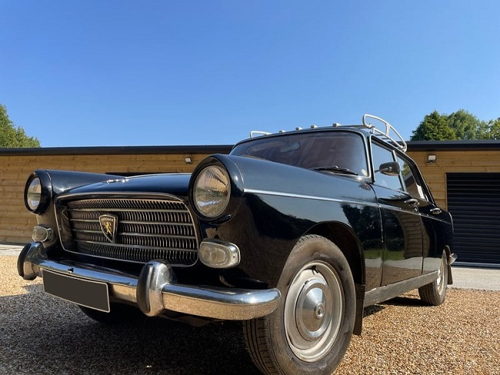Meet the Owner - Mitka Engebretsen and his Peugeot 404
13 January 2025
As many of us know, cinema often has an abiding effect on our perceptions of certain cars. Thanks to various 1960s’ International Adventure’ films screened on television during my youth, the Peugeot 404 always seemed faintly exotic. It might contain five or six overacting villains chasing our hero through Tangiers or Marrakesh or herald the arrival of the Brigade Criminelle in downtown Marseilles.

Meanwhile, this handsome model owned by Mitka Engebretsen - https://www.carandclassic.com/l/C1781545 - seems to have enjoyed a more sedate existence. Norway’s Tidemann Tobacco acquired it in 1965, and the 404 served as directorial transport, meeting VIPs at the airport. Today, it is a reminder of one of Peugeot’s most important models.
After three years of testing, the 404 debuted in May 1960 as the model as the eventual heir to the 403. The Suez Crisis of 1956 meant Peugeot rejected early plans to use a V8 engine in favour of a 1,618cc version of their four-cylinder engine. The Pininfarina bodywork was a significant sales feature, even if one magazine questioned its “perhaps too fashionable aesthetics”.
Autocar noted how “After years of restraint in decor”, Peugeot offered “four bright colours (tango red, turquoise, ivory and pale grey) as well as black”. On the 10th May 1960, the company’s directors were invited to drive a fleet of ivory 404s through Paris to entice Citroën, Renault and Simca drivers to their nearest Peugeot showroom. The price was 9,150 francs, 900f more than the 403, with a sliding roof as a 150f optional extra.

By the summer of 1960, sales passed the 10,000 mark as the 404 had rapidly gained a niche among the ‘Grande Bourgeoisie’ in its home market. The Peugeot was larger than the Simca Aronde and more reassuringly conventional than the Citroën ID19. As for Renault sales of the 2-litre Frégate ended in 1960, and some motorists grumbled its replacement – a Belgian -built Rambler – was a “Voiture Nouveau Riche”.
Import duties inflated the 404’s UK price to the point that in 1965 the De Luxe saloon cost £1,343, compared with £962 for the 3.3-litre Vauxhall Cresta PB. The Peugeot was also more expensive than the Ford Zodiac Mk. III at £1,028, the Triumph 2000 at £1,119 and the Rover P6 at £1,298. Your friendly local Morris dealer could also point out they offered a Pininfarina-styled 1.6-litre saloon in the form of the Oxford VI for only £782 in De Luxe form.
Yet, Peugeot ownership gave the driver the social kudos of possessing a ‘foreign car’ (still a talking point in mid-1960s Britain) and a superbly engineered vehicle. The Motor noted, “different members of our staff returned from journeys in the 404 remarking, “I’d like one of those”. Autocar thought it was “conceived in the best Peugeot tradition”, while the September 1961 edition of Motor Sport believed “the car even smells French”.
1968 saw the launch of the 504, and seven years later, the last of 1,847,568 404s left the Sochaux factory. This was not the end of the narrative, as overseas production continued for several more years, the Nigerian-built examples remaining on sale until 1989.
Mitka’s Peugeot contains all the details I remember of the 404 – the steering column gear lever, the strip speedometer and, of course, the elegant white steering wheel. And it really does look as though it belongs in a 1960s’ International Adventure’ film.
With thanks to Mitka Engebretsen for his time and permission to use the images in this blog.
